Massoud M. Engineering Thermofluids: Thermodynamics, Fluid Mechanics, and Heat Transfer
Подождите немного. Документ загружается.


502 IVa. Heat Transfer: Conduction
− How do you define the heat transfer coefficient? What is the range of h in free
convection for gases?
− A thin disk is being welded at a point located at r and
θ
with 0 < r < D/2 and 0
<
θ
< 2
π
and D is the disk radius. Is temperature distribution in this disk 1-D?
What coordinate system do you use to find temperature distribution in the disk?
− What is the difference between heat transfer coefficient and the overall heat
transfer coefficient?
− Temperature difference across a fuel pellet, operating at q
′
= 10 kW/ft is 700 F.
Maintaining the same
q
′
, what is the change in temperature gradient across the
pellet if the pellet diameter was 10% smaller?
− What is the advantage of an annular fuel as compared with a solid fuel pellet?
− A cylinder has Fo = 0.05. Is the Heisler solution applicable to this cylinder?
− What is the advantage of analytical solution compared with numerical solutions
or experimental correlations?
PROBLEMS
Sections 1 and 2
1. Find an average thermal conductivity for copper in the temperature range of
200 F to 600 F.
2. Two plates are placed in a container. The gap between the plates is 0.01
inches. A vacuum pump is used to remove air from the container. However, a
small amount of air has remained in the container so that air pressure is measured
as 0.1 mbar. Can the air thermal conductivity be obtained from Figure IVa.1.1?
3. Thermal conductivity of a substance is measured as
oo
/ TTkk = . Find an
average value for thermal conductivity in the temperature range of T
1
and T
2
.
[Ans.
)/())(2/(
12
2/3
1
2/3
2
2/1
oo
TTTTTkk −−= ].
4. Heat is being generated in a fuel element at a volumetric heat generation rate of
q
′′′
= 1300 kW/m
3
. The fuel element is a rectangular parallelepiped of thickness 2
cm with a height of 2 m and width of 1 m. The fuel thermal conductivity is k =
3.5 W/m·C. Find the rate of heat transfer from the fuel element at steady state
condition. [Ans.: 52 kW].
5. Heat at a rate of 5 kW is being uniformly produced in a solid cylinder. The
cylinder has a diameter and a length of 2 cm and 4 m, respectively. Find a) the
volumetric and the linear heat generation rates for this cylinder and b) heat flux at
r = D/2. [Ans.:
q
′
= 0.25 kW/m, q
′′
= 19.9 kW/m
2
, and q
′′′
= 3979 kW/m
3
].
6. Consider a solid spherical fuel in which heat at a rate of 1 kW is uniformly
produced in the solid sphere and is removed steadily at the surface. The sphere
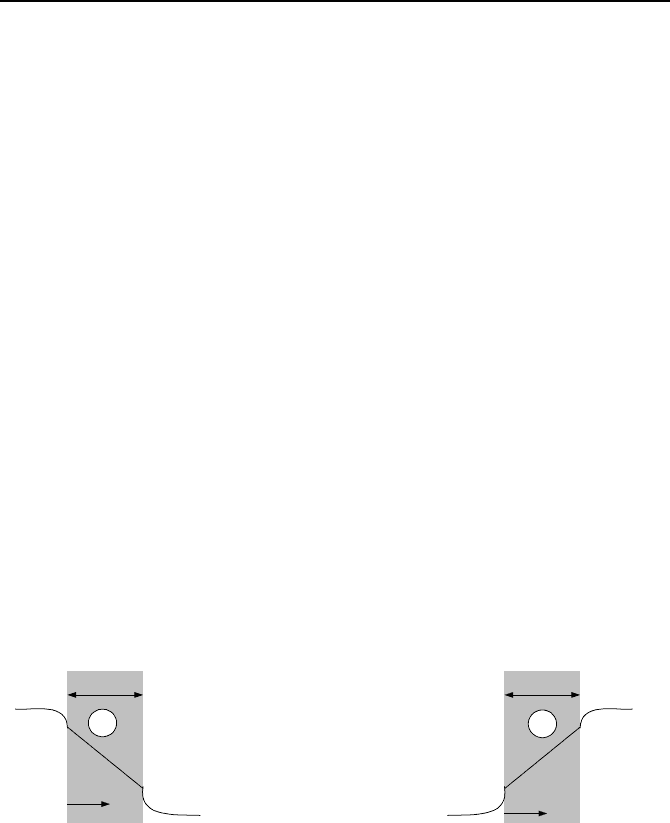
Questions and Problems 503
has a radius of 1 cm. Find the volumetric and the linear heat generation rates for
this sphere.
7. Derive Equation IVa.2.1 from the general form of the conservation equation for
energy as given by Equation IIIa.3.23.
8. A large block of concrete with a thickness of 50 cm is exposed to thermal ra-
diation resulting in the surface temperature to be maintained at 100 C. If the op-
posing surface is kept at 50 C, find a) the rate of heat transfer at steady state condi-
tion per unit surface area and b) temperature at a distance 30 cm from the hot
surface. Assume the concrete thermal conductivity remains constant throughout
the block at 1.4 W/m·K. [Ans.: a) 140 W/m
2
and b) 70 C].
9. A large sheet of steel is exposed to a temperature of 250 C. The sheet has a
thickness of 5 cm and looses heat to an area maintained at 85 C. Find the rate of
heat transfer at steady state condition. The heat transfer coefficients from the hot
side to the sheet is 45 W/m·K and from the sheet to the room is 8 W/m·K.
10. A garment is rated at 150 F for ironing. An iron is set at 200 W. Is this set-
ting appropriate? Assume heat flows primarily from the surface for ironing, hav-
ing an area of A
iron
= 0.4 ft
2
. Other data include h = 10 Btu/ft
2
·h·F and T
ambient
= 70
F. [Ans.: T
iron
= 240 F].
11. As shown in the figure, two plates made of the same material and having con-
stant k are exposed on one side to hot water at T
w
and h
w
and on the other to cold
air at T
a
and h
a
. Using the direction of the x-axis as shown, write the boundary
condition at a) x = 0 and b) x = L for each case.
[Ans. a- at x = 0, B.C.: h
w
(T
w
– T
1,0
) –[–kdT
1
/dx]
0
= 0 and [kdT
2
/dx]
0
– h
a
(T
2,0
–
T
a
)].
L
T
a
h
a
T
w
h
w
x
L
T
a
h
a
T
w
h
w
x
1
2
Figure for Problem 11 Figure for Problem 20
Section 4
12. A piece of copper wire is initially at 150 C. We now expose this wire to air at
38 C. Find a) the rate of heat transfer at the moment of exposure and b) compare
this rate of heat transfer to the rate of heat transfer from thermal radiation at the
moment of exposure.
Data: For copper at 150 C; k = 374 W/m·K, c = 381 J/kg·K,
ρ
= 8938 kg/m
3
,
ε
= 0.8. The heat transfer coefficient is h = 5 W/m
2
·K. [Ans.: Initial heat loss is
64% due to radiation and 36% due to convection].
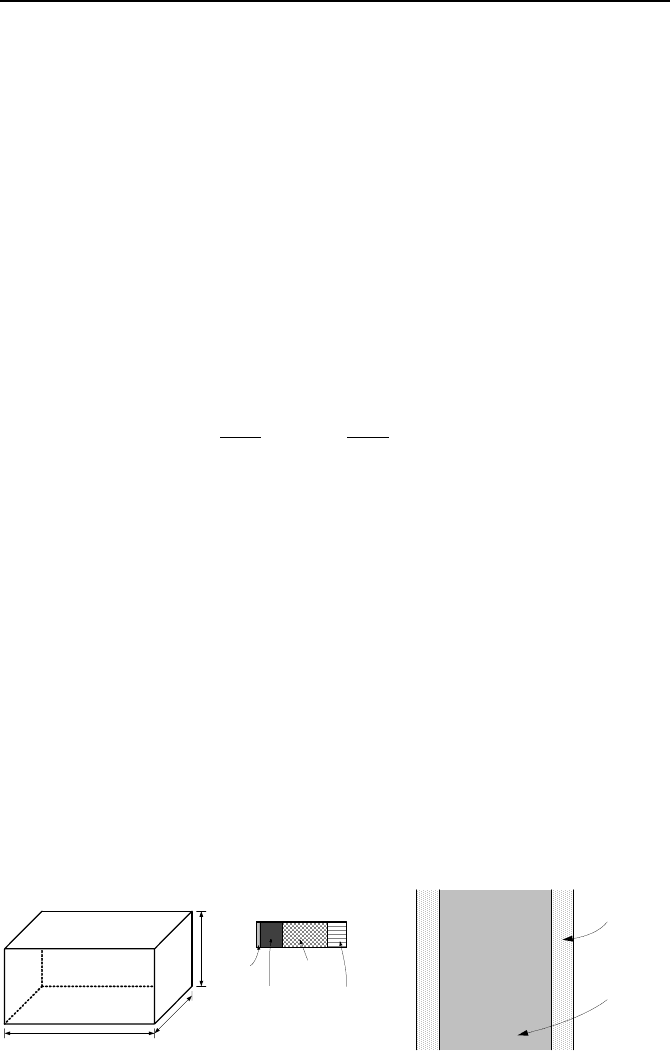
504 IVa. Heat Transfer: Conduction
13. A small copper ball is placed in a room to cool down. Assuming the room
temperature and the heat transfer coefficient remain constant throughout the tran-
sient, find the time at which the sphere temperature reaches half of its initial value.
Data: d = 1 cm, T
i
= 200 C, T
f
= 27 C, h = 8 W/m
2
·C. [Ans.: 10 min].
14. An fuel ball, originally at 100 F is suddenly exposed to a convection bound-
ary. Find the time it takes the fuel to reach 99% of the free stream temperature.
Data: d = 1 in, T
f
= 550 F, h = 180 Btu/h·ft
2
·F. Fuel density = 750 lbm/ft
3
and fuel
specific heat = 0.05 Btu/lbm·F.
15. Consider a fuel pellet of volume V, surface area A, density
ρ
, and specific
heat c. The pellet is initially at temperature T
i
. At time zero, heat is produced in
the pellet at a constant rate of
Q
. At the same time, the pellet is exposed to the
surroundings being at the constant free stream temperature of T
f
. The heat transfer
coefficient between the pellet and the free stream is h. Assuming a lumped heat
capacity method applies a) set up the governing differential equation, b) show that
the pellet temperature versus time (t) is given as:
()
τ
ρ
τ
ρ
τ
VV
)(
/
c
Q
e
c
Q
TTTtT
t
fif
+
»
¼
º
«
¬
ª
+−+=
−
where
τ
=
ρ
cV/hA and c) find the pellet equilibrium temperature (i.e., when t >>
τ
). [Hint: Use Equation IIa.6.4 to obtain the governing differential equation.
Then use Equation VIIb.2.5 to solve the equation].
16. Use the result of the above problem to plot temperature versus time for a cy-
lindrical pellet subject to the simultaneous internal heat generation and exposure
to a convection boundary at time zero. Data: d = 1.00 cm, h = 1.00 cm,
ρ
= 10.4
g/cm
3
, c = 0.35 kJ/kg·K, T
i
= T
f
= 65 C, h = 1200 W/m
2
·C, Q
= 0.05 kW. Use t
1
=
0.001 s, t
2
= 0.7 s, t
3
= 1 s, t
4
= 3 s, t
5
= 6 s, t
6
= 9 s, t
7
= 20 s, t
8
= 30 s, t
9
= 50 s,
and t
10
= 100 s.
Section 5
17. Shown in the figure is a storage facility built in the shape of a parallelepiped.
Details of the walls and the roof are also shown. The thickness of the paint, is
5 mm. The thickness of the sheet rock, insulation, and brick is 4 cm, 15 cm, and 5
cm, respectively. Estimate the heat loss in a Winter day where T
f
= 0 C and the in-
door temperature is maintained at 25 C. Use h
i
= 4 W/m K and h
o
= 10 W/m K.
Paint
50 m
40 m
10 m
Sheet rock
Insulation
Brick
Metal
Fiberglass
Insulation
Figure for Problem 17 Figure for Problem 18
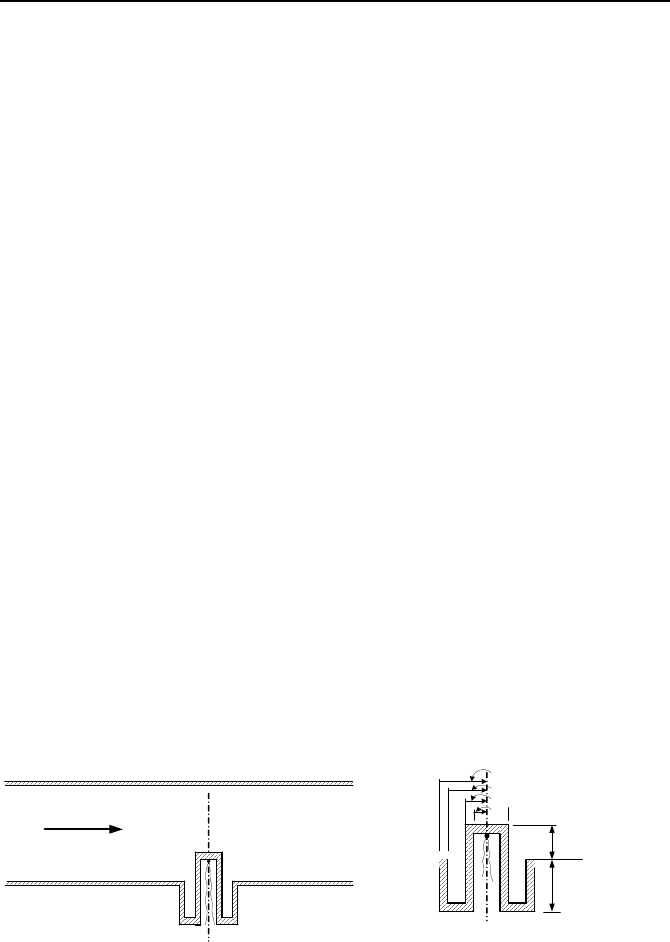
Questions and Problems 505
18. Consider the fiberglass insulation in a kitchen oven, which is sandwiched be-
tween two sheets of metal. The maximum temperature on the inside surface of the
oven may reach 260 C. Find the minimum thickness of the fiberglass insulation to
ensure that the temperature on the outside surface of the oven does not exceed
40 C. The kitchen temperature varies between 18 C to 37 C. The heat transfer
coefficient between the oven surface and the kitchen is 15 W/m
2
·K. The thermal
conductivity of fiberglass is k
fiberglass
= 0.04 W/m·K.
19. Compare the heat losses from a single-pane with a double-pane window. In a
cold Winter day, the room temperature is maintained at 23 C while the outside
temperature is –10 C. The glass thickness is 5 mm and the 2 cm gap in the dou-
ble-pane window is filled with stagnant air. The inside and outside heat transfer
coefficients are 5 W/m
2
·K and 20 W/m
2
·K, respectively. Use k
glass
= 1.4 W/m·K
and k
air
= 0.025 W/m·K.
20. The two plates of Problem 11 made of the same material and having constant
k are exposed on one side to hot water at T
w
and h
w
and on the other to cold air at
T
a
and h
a
. Find a) the equation for temperature profile in these plates and b) tem-
peratures at x = 0 and at x = L if h
w
= h
a
= h.
[Ans.: a)
211
)( cxcxT += where, c
1
= h
w
(T
a
– T
w
)/c
3
and c
2
– T
a
= – h
w
(h
a
L +
k)(T
a
– T
w
)/(h
a
c
3
) where c
3
= (k + h
w
L + h
w
k/h
a
)].
21. The 1 ft thick walls of a building are made of concrete (k = 2 Btu/h·ft·F). The
outside temperature and heat transfer coefficient are 50 F and 2 Btu/h·ft
2
·F, re-
spectively. Find the rate of heat transfer through 1000 ft
2
of the wall if the inside
temperature and heat transfer coefficient are 120 F and 1 Btu/h·ft
2
F, respectively.
Both the inside and the outside of the wall are coated with 20 mils of paint (k = 0.1
Btu/h·ft·F) where 1 mil = 1E-3 in. Compare the results with a bare wall.
22. Shown in the figure is a thermocouple well to measure the temperature of a
high pressure fluid flowing at a distance
δ
1
from the wall. The piping and the
thermocouple well are made of steal. Use the given data to estimate the error in
the thermocouple measurement of the fluid temperature.
T
f
T
w
a
b
δ
1
T
w
T
c
c
d
δ
2
T
c
Data: T
f
= 120 F (49 C), T
w
= 60 F (15.5 C), k
f
= 0.1 Btu/h·ft·F (0.173 W/m·C),
k
w
= 10 Btu/h·ft·F (17.2 W/m·C), h = 20 Btu/h·ft
2
·F (113.6 W/m
2
·C), a = 0.625 in
(1.587 cm) b = 0.5 in (1.27 cm), c = 0.25 in (0.635 cm), d = 0.125 in (0.3175 cm),
δ
1
= 0.5 in (1.27 cm), δ
2
= 2 in (5.08 cm). Ignore thermal radiation.
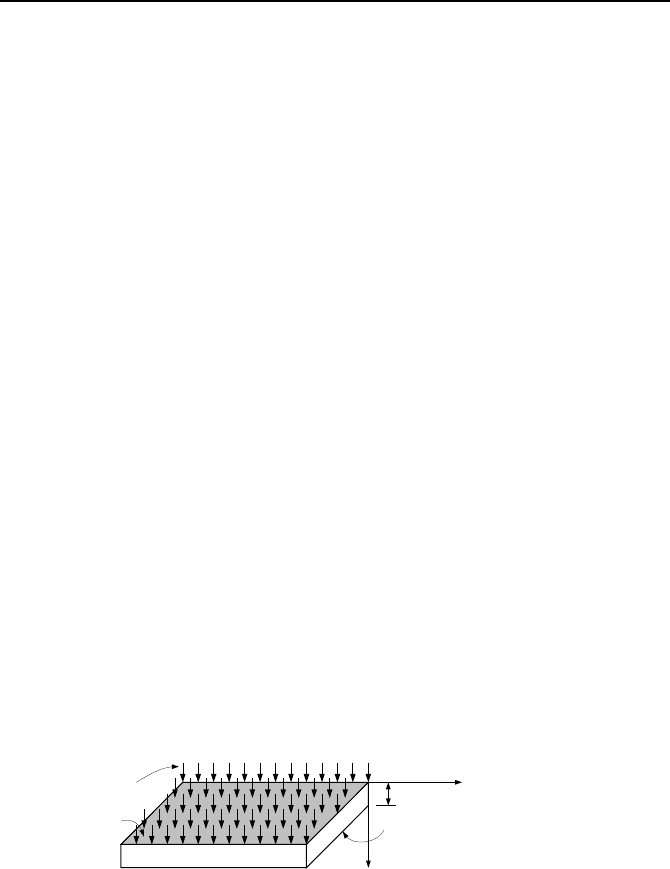
506 IVa. Heat Transfer: Conduction
23. Surface temperature of a bare slab fuel (2L = 2 cm, k = 3.5 W/m C) is 300 C.
The volumetric heat generation rate in the slab is
q
′′′
= 1300 kW/m
3
. Find the
temperature of points located on a vertical plane 0.5 cm from the center plane.
[Ans.: 314 C].
24. Fuel slabs are used in an experimental reactor. Find the maximum fuel tem-
perature for the following data T
f
= 1090 F, L = 0.25 in,
δ
= 0.025 in, k
F
= 1
Btu/ft·h·F, k
C
= 3 Btu/ft·h·F, h = 350 Btu/ft
2
·h·F, and q
′′′
= 1.0E7 Btu/ft
3
·h. [Ans.:
4000 F].
25. Surface temperatures of a plate are maintained at T
0
(x = 0) and T
L
(x = L).
Thermal conductivity of the plate in the temperature range of interest remains con-
stant. Find temperature distribution in the plate for a constant volumetric heat
generation rate. [Ans.:
ξξξ
)()1)(2/()(
0
2
0
TTkLqTxT
L
−+−
′′′
=−
where
ξ
=
x/L].
26. Surface temperatures of a plate are maintained at T
0
(x = 0) and T
L
(x = L).
Thermal conductivity of the plate in the temperature range of interest remains con-
stant. Find a) the maximum temperature in the plate and b) the location of the
maximum temperature for a constant volumetric heat generation rate.
[Ans.:
)2/)(1( Lx
λ
+= where )2//()(
2
0
kLqTT
L
′′′
−=
λ
].
27. Derive Equation IVa.5.16 directly from an energy balance using the elemental
control volume of Figure IVa.5.7.
28. Gamma radiation is bombarding an iron plate as shown in the Figure. Tem-
peratures of the surface at x = 0 and at x = 15 cm are maintained at 371 C and 260
C, respectively. Find the maximum temperature and its location in the plate. Also
find temperature at 1 cm from the side facing the irradiation and the rate of heat
removal from the side not being irradiated. k = 48.5 kW/m·K,
µ
= 24.6 m
–1
.
[Ans.: T
max
= 594 C, x
max
= 4.8 cm].
15 cm
= 19,600 kW/m
3
0
q
′′′
x
T (x = 0) = 371 C
T (x = 15 cm) = 260 C
29. Gamma radiation is bombarding an iron plate as shown in the figure. A con-
vection boundary condition of T
f
= 150 C and h = 200 W/m·K removes heat from
the plate. Find the maximum temperature and its location in the plate. Also find
temperature at 1 cm from the side facing irradiation and the rate of heat removal
from the side not being irradiated. k = 48.5 kW/m K,
µ
= 24.6 m
–1
.
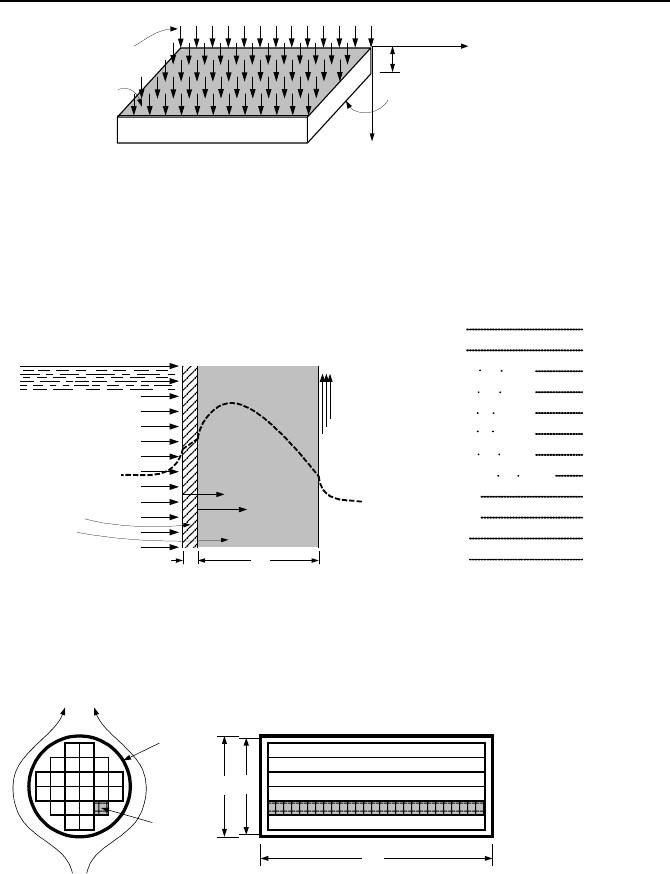
Questions and Problems 507
15 cm
= 19,600 kW/m
3
0
q
′′′
x
T
f
= 150 C
h = 200 W/m K
T
f
= 150 C
h = 200 W/m K
30. Regarding the radiation heating of a spent fuel pool wall, we want to deter-
mine the maximum temperature in the concrete. In the solution, you must account
for heat generation in both steel and concrete. The rate of heat generation in these
mediums follows an exponential profile,
x
eqxq
µ
−
′′′
=
′′′
0
)(
. Find the maximum
temperatures and their locations in both steel liner and concrete. Subscripts a, c, s,
and w are used for air, concrete, steel liner, and water, respectively.
Spent Fuel Pool
Steel Liner
Concrete
T
a
h
a
T
w
h
w
Air
Water
L
δ
x
s
x
c
T
w
(F):
T
a
(F):
h
w
(Btu/h ft
2
F):
h
a
(Btu/h ft
2
F):
k
s
(Btu/h ft F):
k
c
(Btu/h ft F):
130
100
50
1
s
q
′′′
(Btu/h ft
3
F):
c
q )(
0
′′′
(Btu/h ft
3
F):
10
0.8
1500
400
δ
(in):
L (ft):
µ
c
(ft
-1
):
5
5
0.5
µ
s
(ft
-1
):
14
Section 6
31. A dry shielded canister (DSC) is a hermetically sealed circular cylinder, con-
taining spent nuclear fuel assemblies for long time storage. Consider a design in
which the DSC is filled with helium and placed horizontally for passive cooling in
the ambient.
Fuel
Assembly
Dry Shielded
Canister
L
T
f
h
o
D
o
D
i
If there are 26 fuel assemblies in a DSC and each fuel assembly produces a de-
sign decay power of 0.5 kW, estimate the amount of helium mass the DSC should
be filled with so that at the thermodynamic equilibrium, the helium pressure does
not exceed 5 psig. Assume T
f
= 105 F, D
o
= 68 in, D
i
= 65 in, L = 10 ft, h
o
= 10
Btu/h·ft
2
·F. The DSC shell is made of stainless steel. The end plates have the
same thickness as the shell and are made of the same material. An internal heat
transfer coefficient of h
i
= 20 Btu/h·ft
2
·F is found to represent the combined ther-

508 IVa. Heat Transfer: Conduction
mal radiation, heat conduction, and heat convection inside the canister. Ignore
thermal radiation from the canister to the ambient.
32. A bare fuel rod has a diameter of 0.373 in and length of 12 ft. The volumetric
heat generation rate for this rod is
=
′′′
q
10,000 kW/ft
3
. The heat produced by the
rod is removed by water used as the coolant, at 2250 psia and 575 F. Find the heat
transfer coefficient between the bare fuel rod and the coolant. The fuel rod sur-
face temperature is 675 F. [Ans.: h = 2651 Btu/h·ft
2
·F].
33. Working fluid at 35 F flows in a 2 in pipe. Ambient temperature is 125 F.
The pipe is covered with 2 layers of insulation each having a thickness of 5 in with
k
1
= 0.015 Btu/ft·h·F and k
2
= 0.04 Btu/ft·h·F. The pipe is 0.2 in think with k = 8
Btu/ft h F. Find the rate of heat transfer to the working fluid in 100 ft of pipe. As-
sume h
a
= 200 Btu/ft
2
·h·F and h
b
= 15 Btu/ft
2
·h·F. [Ans.: UA = 5 Btu/h·F and Q
=
454.5 Btu/h].
34. A steam pipe, made of copper, has an inside diameter of 5 cm and an outside
diameter of 6.2 cm. To reduce thermal loss to the surroundings, the pipe is insu-
lated with 2.55 cm thick fiberglass. An aluminum foil of thickness of 0.2 mm
covers the insulation. Find the rate of heat loss from the pipe using the following
data: h
i
= 142 W/m K, T
i
= 150 C, h
o
= 68 W/m K, T
o
= 27 C, L
pipe
= 98.5 m.
[Ans.: 0.43 kW].
35. Superheated steam flows in an insulated pipe. Find the rate of heat loss for
the following data.
Region d
i
(cm) d
o
(cm) k (W/m·K)
Pipe 89.0 92.0 50.
Paint 92.0 92.2 3.0
Insulator 1 92.2 100.0 0.2
Insulator 2 100 120.0 0.1
Additional data: T
a
= 350 C, h
a
= 1000 W/m
2
·K, h
b
= 20 W/m
2
·K, T
b
= 20 C, L
= 100 m. [Ans.: UA = 271.3 W/C and
Q
= 0.3 MW].
36. Find the surface temperature, surface heat flux, and linear heat generation rate
of an electric resistor. The resistor is in the form of a solid cylinder of diameter
0.2 in and k = 50 Btu/h·ft·F. Heat is produced uniformly in the cylinder so that
=
′′′
q
5E7 Btu/h·ft
3
. Assume the center temperature is maintained at 300 F. [Ans.:
282.6 F,
=
′′
q
2.08 Btu/h·ft
2
, and =
′
q
3.2 kW/ft].
37. A long and slender shaft of diameter 2R and length L
1
+ L
2
is insulated over
length L
1
and produces heat only in this section while over length L
2
, it is exposed
to a convection boundary (h, T
f
). Write the governing differential equations and
the associated boundary conditions from which temperatures in sections L
1
and L
2
can be obtained. Both ends may be treated as adiabatic surfaces.

Questions and Problems 509
2R
L
1
L
2
q
′′′
x
h, T
f
38. An electric resistor, R = 0.1 in, is steadily generating heat at a rate of q
′′′
=
5E7 Btu/h·ft
3
. The centerline temperature is maintained at 300 F, find surface
temperature, surface heat flux, and
q
′
. k = 50 Btu/ft·h·F. [Ans.: T
s
= 282.6 F,
q
′′
= 2.1E5 Btu/h·ft
2
, and q
′
= 3.2 kW/ft].
39. A fuel rod of a PWR consists of about 320 solid fuel pellets inside a zircaloy
cladding. Use the specified data to plot the distribution of temperature in the fuel
rod. The temperature distribution should include the fuel region, the gap region,
the cladding region, and end at the bulk coolant for two cases of low and high lin-
ear heat generation rates. Data: D
Fuel
= 0.96 cm, D
Inside Clad
= 0.985 cm, D
Outside Clad
= 1.12 cm, k
Fuel
= 1.73 W/m C, k
Clad
= 5.2 W/m·C, T
Water
= 300 C,
Low
q
′
= 5 kW/ft
(164 W/cm), and
High
q
′
= 15 kW/ft (492 W/cm). The heat transfer coefficient
from the fuel rod to bulk coolant is 34 kW/m
2
·C. The heat transfer coefficient in
the gap region is 5.7 kW/m
2
·C for the low and is 11.4 kW/m
2
·C for the high linear
heat generation rate.
40. Use the following data to plot the temperature distribution in a cylindrical fuel
rod for a) a linear heat generation rate of 5 kW/ft and b) a linear heat generation
rate of 15 kW/ft. Data: Fuel diameter = 0.377 in, Clad inside diameter = 0.388 in,
Clad outside diameter = 0.44 in, fuel thermal conductivity = 1 Btu/h·ft·F, cladding
thermal conductivity = 13 Btu/h·ft·F, gap heat transfer coefficient = 1000
Btu/h·ft
2
·F. Heat transfer coefficient to coolant is 6000 Btu/h·ft
2
·F and coolant
temperature is 575 F. The fuel has a central hole but no coolant flows in the cen-
tral hole. The hole has a diameter of 0.04 in.
41. Find the maximum temperature and its location in a two-stream annular fuel
rod with inner and outer cladding. T
i
= 350 C, T
o
= 340 C, h
i
= 10,000 W/m
2
C, h
o
= 8,000 W/m
2
·C, k
F
= 3.5 W/m·C, k
C
= 11 W/m·C, q
′
= 9 kW/ft, d
1
= 5 mm, d
2
=
9 mm, d
3
= 17 mm, d
4
= 21 mm.
[Ans.: c
1
= 141, c
2
= 1250, c
3
= 965, c
4
= 5970, c
5
= –282, c
6
= –908, r
max
= 6.11
mm, T
max
= 568.6 C].
42. A fuel rod is producing heat at a rate of 8 kW/ft. The rod has a central hole.
Helium flows over the rod as well as inside the central hole. Find the maximum
temperature and its location for this fuel rod.
Fuel geometry data: diameter of the central hole: 0.25 in, thickness of the inner
clad: 1/8 in, outside diameter of fuel: 1 in, thickness of outer clad: 1/8 in. Thermal
conductivity data: clad: 30 Btu/h·ft·F, fuel: 1 Btu/h·ft·F. Temperature and heat
transfer coefficient data: bulk fluid temperature in the central hole: 595 F, heat trans-
fer coefficient in the central hole: 3000 Btu/h·ft
2
·F, bulk fluid temperature outside
the fuel rod: 590 F, heat transfer coefficient outside fuel rod: 2500 Btu/h·ft
2
·F.

510 IVa. Heat Transfer: Conduction
43. A two-stream annular fuel rod includes inner and outer cladding. Use the fol-
lowing data and determine equation for temperature as a function of radius for the
inner clad, fuel, and the outer clad regions. Also find the maximum temperature
and its location.
Data: R
1
= 0.25 in, R
2
= 0.27 in, R
3
= 0.55 in, R
4
= 0.58 in, q
′
= 11 kW/ft, k
F
=
3.5 W/m·C, k
C
= 11 W/m·C, T
i
= 350 C, T
o
= 300 C, h
i
= 6,000 W/m
2
·C, h
o
= 4500
W/m
2
·C.
[Ans.: r(T
max
)= 0.39 in, T
max
= 546 C, T
ci
= 182lnr + 1330, T
F
= –5.543E6r
2
+1090lnr + 6120, T
co
= –332lnr –1040 where r is in meter and T in degrees Centi-
grade].
44. Plot the steady state temperature distribution for the fuel rod of Problem 43.
[Ans.: The key temperatures are T
fi
= 350 C, T(R
1
) = 409 C, T(R
2
) = 423 C, T
max
=
546 C, T(R
3
) = 0.378 C, T(R
4
) = 360 C, T
fo
= 300 C. Find the temperature of sev-
eral other points, especially in the fuel region].
45. Two rigid circular cylinders, in perfect contact are pressed together by the ac-
tion of force F. Initially, the cylinders are in thermal equilibrium with the ambient
at temperature T
f
. At time zero cylinders begin to rotate at nominal speeds of ω
1
and ω
2
as shown in the figure. The bottom cylinder rotates clockwise and the up-
per cylinder rotates counterclockwise. The coefficient of dry friction between the
cylinders is
µ
. The heat resulting from the friction of the rotating cylinders, raises
their temperature. Heat transfer coefficient for the upper cylinder surface area is
h
s1
and for the horizontal area is h
a1
. Similarly, heat transfer coefficient for the
bottom cylinder surface area is h
s2
and for the horizontal area is h
a2
. Use these
data and those given in the figure to a) write the differential equations from which
temperature distribution in each cylinder can be obtained and b) identify the initial
and the boundary conditions.
H
1
H
2
R
ω
2
ω
1
F
[Hint: Temperatures are obtained from Equation IVa.2.7 with ∂T/∂
θ
= 0 due to
symmetry in the
θ
direction. There are 2 initial and 8 boundary conditions].
46. Find the governing differential equation for temperature distribution in
spheres with symmetry in
θ
and
φ
directions.
[Ans. 1/r
2
d/dr(r
2
dT/dr) + q
′′′
/k = 0].
Section 7
47. Derive the temperature profile in a thick-wall sphere for a temperature bound-
ary condition (i.e., T(r
1
) = T
1
and T(r
2
) = T
2
). {Ans.: T(r) = [(A/r) – B]/C where
A = (r
1
r
2
T
1
– r
1
r
2
T
2
), B = r
1
T
1
– r
2
T
2
, and C = r
2
– r
1
}.
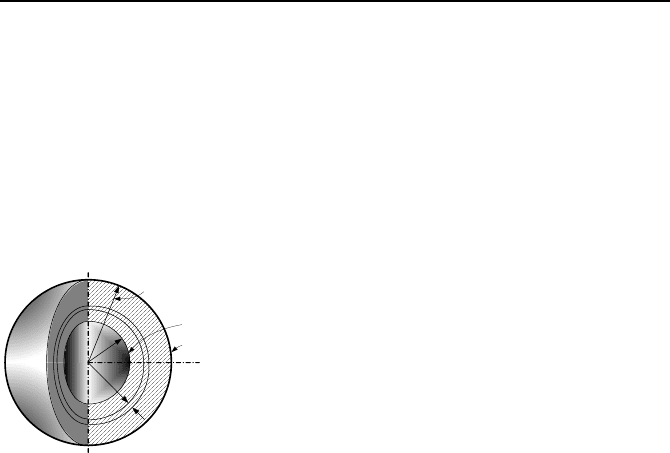
Questions and Problems 511
48. Derive a temperature profile in a thick-wall sphere for a convection boundary,
h
1
[T
f1
– T(r
1
)] = –kdT(r
1
)/dr and h
2
[T(r
2
) – T
f1
] = –kdT(r
2
)/dr. {Ans.: T = T
f1
–
[(T
f1
– T
f2
)/B][A – 1/r] where A = 1/r
1
+ k/h
1
2
1
r and B = C + D where C = 1/r
1
–
1/r
2
and D = k/h
1
2
1
r + k/h
2
2
1
r
49. To find the thermal conductivity of a substance, two hemispheres of this sub-
stance are made to form a sphere. A heat source is placed in the center of this
sphere. Assuming perfect contact of the two halves and isotropic heating of the
inner surface, use the given data to find thermal conductivity. [Ans.: 2 W/m·K].
r
1
r
2
r
dr
T
1
T
2
R
1
=
R
2
=
T
1
=
T
2
=
10 cm
15 cm
340 C
300 C
Q
=
300 W
50. A thick-wall spherical container is filled with a hot liquid. A pump circulates
the liquid to maintain the bulk temperature at 150 C. Ignore temperature gradient
in the liquid. Find temperature in the middle of the wall and the energy required
to keep liquid temperature at 150 F for an hour. D
i
= 3 m,
δ
wall
= 20 cm, k = 20
W/m·C, T
fi
= 150 C, T
fo
= 25 C, h
i
= 500 W/m
2
·C, and h
o
= 10 W/m
2
·C.
51. A spherical fuel element has a center temperature of 3600 F. The fuel ele-
ment is covered by two layers of coating. The fuel ball is cooled by helium. Find
the rate of heat transfer. Data: r
fuel
= 0.5 in, r
1
= 0.7 in, r
2
= 0.9 in. k
fuel
= 2
Btu/ft·h·F, k
coating
= 7 Btu/ft·h·F, T
f
= 700 F and h = 5000 Btu/ft·h·F. [Ans.: 4100
Btu/h].
52. Derive the temperature profile in a hollow and bare spherical fuel ball. [Ans.:
T = –(
q
′′′
/6k
F
)r
2
– c
1
/r + c
2
where c
1
= q
′′′
3
1
r /3k
F
and c
2
= T
f
+ c
1
[
α
– (
β
k
F
/h)]
where
α
= 1/r
2
+
2
2
r /2
3
1
r and
β
= r
2
/
3
1
r + 1/
2
2
r ]
Section 8
53. A stainless steel spoon is used to stir hot tea maintained at 49 C. The spoon
can be approximated as a rectangular parallelepiped having a length of 15 cm, a
width of 6 mm and a thickness of 2 mm. The exposed length of the spoon to the
ambient at 18 C is 5 cm. Find a) the rate of heat loss from the spoon assuming an
average heat transfer coefficient of 6 W/m
2
·K with the ambient and b) fin effi-
ciency. [Ans.: § 0.1 W, 25%].
54. As shown in the figure, to dissipate heat from an electrical appliance, thin
plates of metal with a thermal conductivity of 10 Btu/h·ft·F are used. Find the
